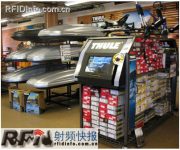
Fully self-service stores will replace labor with RFID systems
[ad_1]
The food retail industry research and consulting company, European Food Information Service (European FIS), is currently discussing with retailers in the Netherlands and Belgium to deploy prefabricated automated stores that sell high-end food or other items. This kind of prefabricated store applies self-locking doors, RFID technology and cameras, without staff involvement.
The prefabricated store is called “Food Store 24”, which is inspired by a similar system installed by Laxbutiken in the Laxomat self-service convenience store operated by Laxbutiken. Laxbutiken is a Swedish salmon specialty restaurant. Laxbutiken has two Laxomat stores—one in Heidelberg and the other in Lonskil—where customers can buy packaged foods such as salmon and salads, as well as bottled beverages. The store relies on the RFID tags on the goods and the RFID readers of the sales terminal to fully realize self-service, without any staff for purchasing.
In these prefabricated stores, the German system integrator IAL Automation und Logistik provides RFID readers, tags and middleware, which can realize the automated services of the store 24 hours a day without the need for night shifts. The opening hours of most stores in Europe are generally from eight in the morning to eight in the evening. If you want to extend the operating hours, you need to increase the staff. Even a small shop usually has to have two staff members staying behind to ensure safety.

Self-service shop
However, the application of the “Food Store 24” system enables the store to operate as usual without staff. Through this large-scale system, customers can enter the store to buy goods and complete transactions at any time without personnel assistance. Dieter Nimitz, president of IAL, said that this fully automated solution includes setting up prefab shops, although some retailers just choose to buy RFID solutions in their own shops.
Nimitz said that because this fully self-service store is easier to transport, it is more convenient for retailers and restaurants to use and easier to market. He pointed out that this store can be placed next to a crowded parking lot near theaters or concerts, or other areas with heavy traffic, or it can be placed in ski resorts in winter or beach areas in summer. It can even be installed in residential areas if needed. “If the store finds that there is not a lot of traffic in the location,” he said, “they can move this kind of store to another place.”
According to European FIS Director Sylvia Pfaff, the operating process of this kind of store is: If you want to enter the store, the user can insert a credit or debit card in the groove of the front door and enter the card’s 4-digit code. If the password is accepted, the store door will be automatically unlocked, and the individual can enter the lobby at this time. Then, the information on the card will be stored in the back-end system, and the owner of the store can access it remotely through a browser connection. After the outer door of the lobby is closed, the second door will be unlocked and users can enter the store.
At the entrance of the store, customers can take a shopping bag. Each item in the store will be affixed with an HF 13.56 MHz RFID tag, which conforms to ISO 18000-3, ISO 14443 or ISO 15693 standards and has a short reading range. IAL has not yet identified a specific label supplier, Nimitz said, “We have been working with several hardware suppliers.”
After the customer purchases the goods, they go to the checkout area and put the entire bag on the counter close to the RFID reader of the sales terminal. The reader reads the ID numbers of all goods tags, and the Ial software concatenates these ID numbers with the price data in the product and the back-end system. The touch screen of the terminal will display the total price of the purchased goods. If the customer does not want to buy a certain item, he can take the item out of the bag and put the bag back on the counter.
Once ready to pay, customers can insert a debit or credit card into the sales terminal to complete the payment. The unique ID number on the product will be automatically updated after the back-end system is sold, and the store door will be automatically unlocked. The customer passes through an exit equipped with another RFID reader. In this process, the reader will read the ID number on the labeled commodity passing through the exit and compare it with the ID number of the purchased commodity.
If a customer wants to eliminate a product that has not been purchased, the system will automatically warn that the product has not been paid for. If the customer goes out without paying, the store will record the person’s identification number and the cancelled product ID number. In addition, the store will be equipped with a monitor, and when a sales discrepancy occurs, it can be reviewed through video.
If the customer chooses not to buy anything, he can use his credit or debit card to open the store again before leaving. Although Pfaff said that emergency exits are always open, all store doors are always closed regardless of whether it is an entrance or an exit.
Pfaff said that the company is currently discussing with food retailers that this kind of mobile store will eventually be used to sell other small, high-priced items (such as CDs, books, or DVDs). Both IAL and European FIS initially marketed this system in Nordic countries, where credit card payments are generally higher than in Southern Europe. The system does not accept cash payments.
[ad_2]






